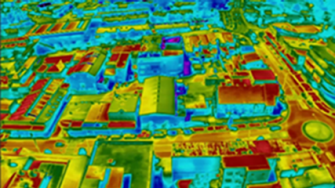
Project Aim (and/or Objectives)
The present study is aiming to analyse the problem of urban overheating in the City of Parramatta Local Government Area (LGA), evaluate its impact on energy, peak electricity demand and health and propose quantified mitigation policies to counterbalance the overheating problem.
The temperature of cities continues to increase because of the heat island phenomenon and the undeniable climatic change. The City of Parramatta is an overheated city. It presents almost 3-4 °C higher temperature during the summer period compared to the Eastern Suburbs. The energy consumption of buildings is considerably higher than that in the coastal zones, while the heat-related morbidity is constantly increasing during the last years. Predictions of the future, 2050, climatic conditions, has shown that the peak temperature in the City of Parramatta may increase in average close to 4 °C, following the global overheating trends of Sydney which will have a serious impact on the quality of life, economy, energy consumption and health of urban citizens.
The project deals with the optimization of the climatic and microclimatic conditions in four future precincts in the South Creek of Sydney. The future precincts are:
- Combined Bringelly Town Centre and Rossmore
- St Mary’s
- Elisabeth Drive
- Maryland
The specific objectives of the study are:
- To evaluate and understand in detail the characteristics of the urban overheating problem in Parramatta LGA through the use of experimental and modelling studies.
- To forecast the future urban overheating characteristics taking into account the dynamic evolution of the economic development and climatic conditions in the area.
- To assess the current impact of urban overheating on energy, thermal comfort, peak electricity demand, health, and the global economy.
- To propose advanced mitigation techniques aiming to decrease the ambient temperature and improve thermal comfort conditions and assess their climatic impact in detail.
- To evaluate the impact of the proposed mitigation technologies on energy, thermal comfort, peak electricity demand, health, and economy.
- To create a permanent infrastructure, to collect climatic information, assess the impact of the climatic conditions and forecast the potential impact of future mitigation policies in the City of Parramatta.
Multiple measurement techniques and advanced simulation techniques have been used to analyse the specific characteristics of the urban overheating in the City of Parramatta (by focusing on two of the main zones: Parramatta CBD and Epping)
Project Outcomes
- Because of the intense climatic change, the ambient temperature in the City of Parramatta by 2050 will increase by several degrees. The expected average increase is close to 3-4 °C.
- Additional construction and increase of the density in Western Sydney by 2050 will further increase the ambient temperature, by 1-2 °C compared to a scenario considering the 2050 climatic conditions and the 2018 land use.
- The implementation of advanced mitigation technologies can reduce the peak ambient temperature in the City of Parramatta, up to 1.9 °C, and compensate the impact of the additional urbanization and part of the impact of climate change.
- The impact of temperature increase caused by the climatic change and additional urbanization on the energy consumption of buildings is tremendous and may increase the actual energy consumption of buildings in the City of Parramatta by 66 %.
- The use of global climate mitigation techniques may decrease the projected energy consumption of buildings for 2050 up to 10 %.
- The magnitude of the expected climate change in Sydney and in the City of Parramatta is very high. Thus, heat mitigation strategies will be necessary but not sufficient to counterbalance and minimise the expected adverse impacts of urban overheating on the energy and heat-related health risks (mortality and morbidity). Adaptation countermeasures – including a radical improvement of the building quality and indoor environmental conditions – will be fundamental to manage the issue.
- Adaptation techniques to decrease the energy consumption of the buildings should be considered to assess their energy potential for different climatic scenarios.
Therefore, this study suggests that adaptation techniques in combination with mitigation technologies should be immediately implemented to protect the population by the expected temperature increase.
Project Participants
Project Leader: Scientia Prof Mattheos Santamouris
Research team: Dr Riccardo Paolini, Dr Shamila Haddad, Dr Afroditi Synnefa, Samira Garshasbi, Gertrud Hatvani-Kovacs, Dr Komali Yenneti, Jie Feng, Kai Gao.
Contact
Prof. Mattheos Santamouris m.santamouris@unsw.edu.au
